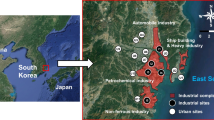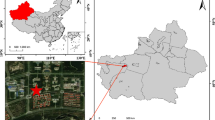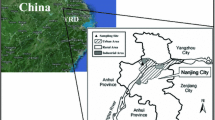Abstract
This paper focused on VOCs and their source apportionment in urban Beijing. Our monitoring measured 52 VOCs in July 2014 and January 2015. The concentration of VOCs was in the range of 14.5~95.2 ppb in July and 2.1~93.1 ppb in January, with the top five compounds of toluene (10.7%), ethane (6.9%), ethylene (6.3%), n-butane (5.7%), and propane (5.6%) in July and ethylene (14.7%), n-butane (14.2%), ethane (9.6%), propylene (8.0%), toluene (7.9%), and benzene (6.9%) in January. The ratio of VOCs to CO reached 0.059 in July and 0.022 in January on average. These differences implied a potential seasonal difference in the VOC source contribution. Then, we conducted a source apportionment study based on 21 major VOCs and CO by using probabilistic matrix factorization (PMF) receptor model. According to the similarity between the PMF analysis profiles and the known source profiles, combustion sources, petrochemical industry sources, solvent utilization sources, and gasoline evaporation sources were identified. The correlation coefficient (R) between the PMF analysis profile and the source profile reached 0.68~0.87 in July and 0.53~0.92 in January. The better apportionment performance in July was mainly due to the use of intensive VOC observations at a 3-h resolution. When we conducted another PMF source apportionment for July based on 12-h resolved concentration input, the R values decreased to 0.47~0.73. Thus, the PMF model depends heavily on the sample number of concentration inputs, and intensive observation is more propitious. Our PMF apportionment results showed that combustion sources, petrochemical industry, solvent utilization, gasoline evaporation, and other sources contributed ambient VOCs in Beijing urban areas of 13.7 ppb, 5.1 ppb, 7.7 ppb, 12.8 ppb, and 3.3 ppb in July and 13.2 ppb, 2.0 ppb, 5.7 ppb, 6.6 ppb, and 1.0 ppb in January, respectively, on a monthly average. These apportionment results match well with the 2013 VOC emission inventory calculated by this study, but also presented significant seasonal differences in the petrochemical industry and gasoline evaporation, in which VOC emissions strongly respond to environmental temperature.





Similar content being viewed by others
References
Baudic, A., Gros, V., Sauvage, S., Locoge, N., Sanchez, O., Sarda-Estève, R., et al. (2016). Seasonal variability and source apportionment of volatile organic compounds (VOCs) in the Paris megacity (France). Atmospheric Chemistry and Physics, 16(18), 11961–11989.
BJMPB (Beijing Municipal Environmental Protection Bureau) and BJIEP (Beijing Municipal Research Institute of Environmental Protection). (2014). General report on the survey of volatile organic compounds pollution sources in Beijing. http://www.cee.cn.
BMBS (Beijing Municipal Bureau of Statistics). (2014). Beijing Statistical Yearbook. Beijing: China Statistics Press.
Cao, H. Y., Pan, Y. P., Wang, H., Tan, J. H., & Wang, Y. S. (2013). Concentrations and Ozone Formation Potentials of BTEX during 2008-2010 in urban Beijing, China. Environmental Sciences, 64, 2065–2070.
Cao, X., Yao, Z., Shen, X., Ye, Y., & Jiang, X. (2015). On-road emission characteristics of VOCs from light-duty gasoline vehicles in Beijing, China. Atmospheric Environment, 124, 46-155.
Cheng, S. Y., Li, W. Z., Wei, W., Li, G. H., Wang, H. Y., Jiang, C. Z., & Zhou, Y. (2013). Refinery VOCs seasonal composition and analysis of ozone formation potential. Journal of Beijing University of Technology, 39(3), 438–444.
CNCIA (China Coatings Industry Association). (2014). China coatings industry yearbook. Beijing: CNCIA.
CPCIF (China Petroleum and Chemical Industry Federation). (2014). China chemical industry yearbook. Beijing: China Chemical Information Center Press.
CTA (China Transportation Association). (2014). China traffic yearbook. Beijing: China Transportation press.
Dai, T. Y., Wang, W., Ren, L. H., Chen, J. H., & Liu, H. J. (2010). Emissions of non-methane hydrocarbons from cars in china. Scientia Sinica Chimica, 53(1), 263–272.
ESDNBS (Energy Statistics Department of the National Bureau of Statistics). (2014). China Energy Statistical Yearbook. Beijing: China Statistics Press.
Gao, S., Jin, L. M., Shi, J. W., Han, B., Wang, X. Y., Peng, Y., Zhao, L. J., & Bai, Z. P. (2012). VOCs emission characteristics and emission factors of light-duty gasoline vehicles with bench test. China Environmental Science, 32(3), 397–405.
He, Q. S., Yan, Y. L., Li, H. Y., Zhang, Y. Q., Chen, L. G., & Wang, Y. H. (2015). Characteristics and reactivity of volatile organic compounds from non-coal emission sources in China. Atmospheric Environment, 115, 153–162.
Li, G. (2014). Research on typical VOCs emission sources classification and optimized reduction strategy. ( PhD thesis).
Li, J., Xie, S. D., Zeng, L. M., Li, L. Y., Li, Y. Q., & Wu, R. R. (2015a). Characterization of ambient volatile organic compounds and their sources in Beijing, before, during, and after Asia-Pacific Economic Cooperation China 2014. Atmospheric Chemistry and Physics, 15(14), 7945–7959.
Li, L., Xie, S., Zeng, L., Wu, R., & Li, J. (2015b). Characteristics of volatile organic compounds and their role in ground-level ozone formation in the Beijing-Tianjin-Hebei region, china. Atmospheric Environment, 113, 247–254.
Li, G., Wei, W., Shao, X., et al. (2018). A comprehensive classification method for VOC emission sources to tackle air pollution based on VOC species reactivity and emission amounts. Journal of Environmental Sciences, 67(05), 81–91.
Liu, Y., Shao, M., Fu, L., Lu, S., Zeng, L., & Tang, D. (2008). Source profiles of volatile organic compounds (VOCs) measured in China: part I. Atmospheric Environment, 42(25), 6247–6260.
MEP (Ministry of Environmental Protection of China). (2014). Technical guide of emission inventory compilation of atmospheric volatile organic compounds (Trial). http://www.mee.gov.cn.
Mo, Z. W., Niu, H., Lu, S. H., Shao, M., & Gou, B. (2015). Process-based emission characteristics of volatile organic compounds (VOCs) from paint industry in the yangtze river delta, china. Environmental Sciences, 36(6), 1944.
Mo, Z., Shao, M., & Lu, S. (2016). Compilation of a source profile database for hydrocarbon and OVOC emissions in China. Atmospheric Environment, 143, 209–217.
Ohara, T., Akimoto, H., Kurokawa, J., Horii, N., Yamaji, K., Yan, X., & Hayasaka, T. (2007). An Asian emission inventory of anthropogenic emission sources for the period 1980-2020. Atmospheric Chemistry and Physics, 7(3), 6843–6902.
Ou, J. M., Feng, X. Q., Liu, Y. C., Gao, Z. J., Yang, Y., Zhang, Z., Wang, X. M., & Zheng, J. Y. (2014). Source characteristics of VOCs emissions from vehicular exhaust in the Pearl River Delta region. Acta Scientiae Circumstantiae, 34, 826–834.
Reff, A., Eberly, S. I., & Bhave, P. V. (2007). Receptor modeling of ambient particulate matter data using positive matrix factorization: review of existing methods. Journal of the Air & Waste Management Association, 57(2), 146–154.
Saeaw, N., & Thepanondh, S. (2015). Source apportionment analysis of airborne VOCs using positive matrix factorization in industrial and urban areas in Thailand. Atmospheric Pollution Research, 6(4), 644-650.
Sarkar, C., Chatterjee, A., Majumdar, D., Ghosh, S. K., Srivastava, A., & Raha, S. (2014). Volatile organic compounds over eastern himalaya, india: temporal variation and source characterization using positive matrix factorization. Atmospheric Chemistry and Physics, 14(23), 32133–32175.
Scheff, P. A., & Wadden, R. A. (1993). Receptor modeling of volatile organic compounds. 1. Emission inventory and validation. Environmental Science & Technology, 27(4), 617–625.
SEDRI (Sinopec Economic and Development Research Institute). (2014). Market data book of petroleum and petrochemical products. Beijing: Sinopec Economic and Development Research Institute Press.
Shi, Y., Lin, H., & Li, Y. (2017). IU-PMF: Probabilistic matrix factorization model fused with item similarity and user similarity. International Conference on Cloud Computing and Security. Cham: Springer.
Song, Y., Shao, M., Liu, Y., Lu, S., Kuster, W., Goldan, P., et al. (2007). Source apportionment of ambient volatile organic compounds in beijing. Environmental Science & Technology, 41(12), 4348–4353.
US EPA. (1999). Compendium method TO-15 determination of volatile organic compounds (VOCs) in air collected in specially-prepared canisters and analyzed by gas chromatography/mass spectrometry. Washington: Office of Air Quality Planning and Standards.
Wang, H. L., Qiao, Y. Z., & Chen, C. H. (2014). Source profiles and chemical reactivity of volatile organic compounds from solvent use in Shanghai. Aerosol and Air Quality Rearch, 14, 301–310.
Wei, W. (2009). Research and forecast on Chinese anthropogenic emissions of volatile organic compounds. Tsinghua University. ( PhD thesis)
Wei, W., Cheng, S., Li, G., Wang, G., & Wang, H. (2014). Characteristics of volatile organic compounds (VOCs) emitted from a petroleum refinery in Beijing, China. Atmospheric Environment, 89, 358–366.
Wei, W., Cheng, S., & Chen, X. (2016). Impact of emission control on PM 2.5 and the chemical composition change in Beijing-Tianjin-Hebei during the APEC summit 2014. Environmental Science and Pollution Research, 23(5), 4509–4521.
Wu, Y., Yang, Y. D., Shao, M., & Lu, S. H. (2015). Missing in total OH reactivity of VOCs from gasoline evaporation. Chinese Chemical Letters, 26(10), 1246–1248.
Wu, R. R., Bo, Y., Li, J., Li, Y. Q., & X, S. D. (2016). Method to establish the emission inventory of anthropogenic volatile organic compounds in China and its application in the period 2008–2012. Atmospheric Environment, 127, 244–254.
Yang, T., Li, D. D., Shan, X. L., Wang, X. Z., Zhang, W. Q., Zhang, Y. J., et al. (2017). Pollution characterization, source apportionment and health risk assessment of benzene homologues in the ambient air of a typical urban area in Beijing,China. Asian Journal of Ecotoxicology, 12(5), 79-97.
Yuan, B., Shao, M., Lu, S., & Wang, B. (2010). Source profiles of volatile organic compounds associated with solvent use in Beijing, China. Atmospheric Environment, 44(15), 1919–1926.
Zhang, Y., Wang, X., Zhang, Z., Lü, S., Shao, M., Lee, F. S. C., et al. (2013). Species profiles and normalized reactivity of volatile organic compounds from gasoline evaporation in China. Atmospheric Environment, 79, 110–118.
Zhang, Z., Zhang, X., Gong, D., Kim, S. J., Mao, R., & Zhao, X. (2016). Possible influence of atmospheric circulations on winter hazy pollution in Beijing-Tianjin-Hebei region, northern China. Atmospheric Chemistry and Physics, 15(16), 22493–22526.
Zheng, J., Yu, Y., Mo, Z., Zhang, Z., Wang, X., Yin, S., et al. (2013). Industrial sector-based volatile organic compound (VOC) source profiles measured in manufacturing facilities in the pearl river delta, China. Science of the Total Environment, 456-457, 127–136.
Funding
This research was funded by National Natural Science Foundation of China under Grant No. 51678007, and Beijing Municipal Science and Technology Commission under Grant Nos. Z171100001117098 and Z181100005418015.
Author information
Authors and Affiliations
Corresponding author
Additional information
Publisher’s note
Springer Nature remains neutral with regard to jurisdictional claims in published maps and institutional affiliations.
Rights and permissions
About this article
Cite this article
Wei, W., Ren, Y., Yang, G. et al. Characteristics and source apportionment of atmospheric volatile organic compounds in Beijing, China. Environ Monit Assess 191, 762 (2019). https://doi.org/10.1007/s10661-019-7813-5
Received:
Accepted:
Published:
DOI: https://doi.org/10.1007/s10661-019-7813-5




